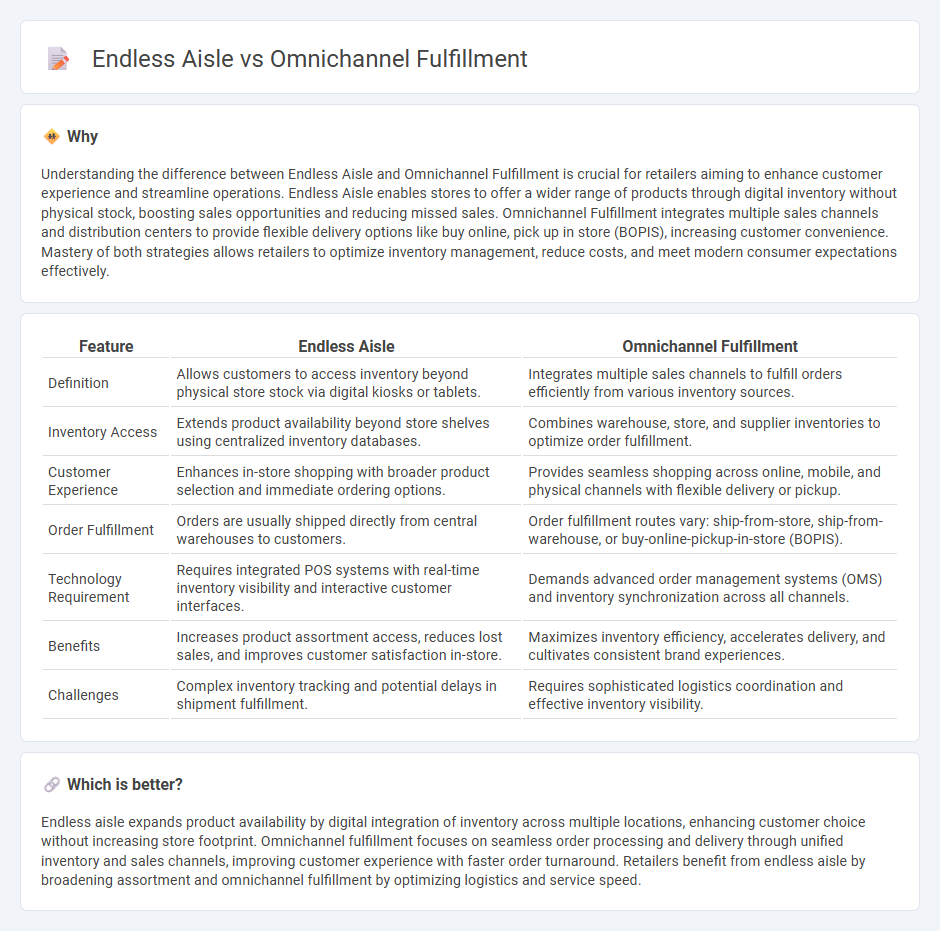
Endless aisle technology enhances retail by offering customers access to a vast inventory beyond physical store limitations, seamlessly integrating online and in-store shopping experiences. Omnichannel fulfillment focuses on optimizing order delivery through multiple channels like in-store pickup, home delivery, and ship-from-store, ensuring convenience and speed. Explore how combining these strategies can revolutionize retail operations and customer satisfaction.
Why it is important
Understanding the difference between Endless Aisle and Omnichannel Fulfillment is crucial for retailers aiming to enhance customer experience and streamline operations. Endless Aisle enables stores to offer a wider range of products through digital inventory without physical stock, boosting sales opportunities and reducing missed sales. Omnichannel Fulfillment integrates multiple sales channels and distribution centers to provide flexible delivery options like buy online, pick up in store (BOPIS), increasing customer convenience. Mastery of both strategies allows retailers to optimize inventory management, reduce costs, and meet modern consumer expectations effectively.
Comparison Table
| Feature | Endless Aisle | Omnichannel Fulfillment |
|---|---|---|
| Definition | Allows customers to access inventory beyond physical store stock via digital kiosks or tablets. | Integrates multiple sales channels to fulfill orders efficiently from various inventory sources. |
| Inventory Access | Extends product availability beyond store shelves using centralized inventory databases. | Combines warehouse, store, and supplier inventories to optimize order fulfillment. |
| Customer Experience | Enhances in-store shopping with broader product selection and immediate ordering options. | Provides seamless shopping across online, mobile, and physical channels with flexible delivery or pickup. |
| Order Fulfillment | Orders are usually shipped directly from central warehouses to customers. | Order fulfillment routes vary: ship-from-store, ship-from-warehouse, or buy-online-pickup-in-store (BOPIS). |
| Technology Requirement | Requires integrated POS systems with real-time inventory visibility and interactive customer interfaces. | Demands advanced order management systems (OMS) and inventory synchronization across all channels. |
| Benefits | Increases product assortment access, reduces lost sales, and improves customer satisfaction in-store. | Maximizes inventory efficiency, accelerates delivery, and cultivates consistent brand experiences. |
| Challenges | Complex inventory tracking and potential delays in shipment fulfillment. | Requires sophisticated logistics coordination and effective inventory visibility. |
Which is better?
Endless aisle expands product availability by digital integration of inventory across multiple locations, enhancing customer choice without increasing store footprint. Omnichannel fulfillment focuses on seamless order processing and delivery through unified inventory and sales channels, improving customer experience with faster order turnaround. Retailers benefit from endless aisle by broadening assortment and omnichannel fulfillment by optimizing logistics and service speed.
Connection
Endless aisle technology extends retail inventory beyond physical store limits by integrating with omnichannel fulfillment systems that synchronize online and offline stock data in real-time. This connection enables customers to access a wider product selection through multiple channels while ensuring efficient order fulfillment from the most optimal location. Retailers leverage this synergy to enhance customer experience, increase sales conversion, and optimize supply chain operations.
Key Terms
Omnichannel fulfillment:
Omnichannel fulfillment integrates inventory, processing, and shipping across physical stores, online platforms, and mobile channels to ensure seamless customer experiences and faster delivery. Retailers leveraging omnichannel fulfillment can optimize stock levels, reduce order fulfillment times, and increase customer satisfaction by providing flexible pickup and return options. Discover how omnichannel fulfillment transforms retail operations and boosts competitive advantage.
Inventory synchronization
Omnichannel fulfillment integrates inventory across all sales channels, ensuring real-time synchronization and accurate stock visibility to streamline order fulfillment and enhance customer satisfaction. Endless aisle extends inventory availability by allowing customers to purchase products not physically in-store, relying heavily on seamless backend inventory synchronization to avoid stockouts or overselling. Explore how advanced inventory management systems optimize synchronization for both models and improve omnichannel retail success.
Order routing
Omnichannel fulfillment optimizes order routing by integrating inventory across physical stores, warehouses, and online channels to ensure the fastest and most cost-effective delivery. Endless aisle expands product availability by allowing retailers to route online orders directly to suppliers or remote warehouses when items are out of stock locally. Discover how strategic order routing enhances customer satisfaction and boosts sales in both omnichannel fulfillment and endless aisle models.
Source and External Links
Omnichannel order fulfillment - Wikipedia - Omnichannel fulfillment is a strategy that treats inventory as fully available across all channels from a single location, using one workforce and inventory pool to serve e-commerce, in-store, and wholesale channels, improving efficiency and customer experience by unifying order processing and shipment handling.
What is Omnichannel Fulfilment? Meaning, Strategies, & Example - Omnichannel fulfillment centralizes inventory and order management across multiple sales channels, allowing customers to, for example, buy online and pick up in store, while the system updates inventory in real time and coordinates fulfillment to improve convenience and sales.
Omnichannel fulfillment vs. multichannel fulfillment - Omnichannel fulfillment unifies inventory management and order processing for all sales channels, maintaining a single inventory and order fulfillment process regardless of where purchases are made, unlike multichannel fulfillment which manages separate inventories and processes by channel.
 dowidth.com
dowidth.com